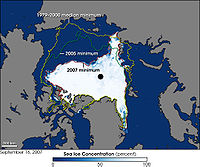Arctic ice thickness decreasing, suggests satellite data study
Tuesday, October 28, 2008

A recent study based on satellite radar altimetry indicates drastic thinning of Arctic ice during the winter of 2007. It was found that the ice thickness had been fairly constant for the five previous winters. The researchers were able to highlight widespread ice thinning in areas covered by both old and young ice. This thinning constitutes the most severe since records started being taken in the early 1990s.
The study by scientists of University College London has been published in the journal Geophysical Research Letters. The work provides the first definitive proof for overall decrease in Arctic ice volume, claim the authors.
The researchers have found that last winter's ice thickness represented a decrease of an average of 26 centimeters below the 2002-2008 winter average. The greatest decline of 49 centimeters was in the western Arctic, which could explain the region's becoming relatively ice-free this summer, allowing it to be open to shipping for the first time in 30 years. The record low of ice thickness during summer happened when the weather was not abnormally warm.
Katharine Giles, the lead author, points out that the study used satellite data sets, which had a number of advantages over other methods. Previous studies have used measurements from drilling, or submarine and airborne surveys. These studies could be severely limited by time and space. The present study utilized continuous, all-weather, day-and-night radar altimeter data from the European Space Agency's Envisat satellite. The study measured ice thickness from October to March, 2007, over more than half of the Arctic.
There has been considerable uncertainty over the causes of ice loss in the Arctic. It has been debated that ice could have been piled up against the coast, thus reducing the sea ice extent. Measurements of the ice thickness, as in the present study, give definite proof for ice melting. "So this means melting; it doesn't mean that the ice has just been pushed up against the coastline," remark Seymour Laxon, co-author of the paper.
The conclusions of the study can help predict what could happen with the ice cover in future. Deflection of sunlight by the Arctic ice cap could be reduced, leading to larger areas of water, which can absorb heat. Warmer temperatures will in turn promote more ice melting. "About five years ago, the average projection for the sea ice disappearing was about 2080", said Dr Laxon. "But the ice minimums, and this evidence of melting, suggests that we should favor the models that suggest the sea ice will disappear by 2030-2040, but there is still a lot of uncertainty."
Sources
- Mark Kinver. "Arctic ice thickness 'plummets'" — BBC News Online, October 28, 2008
- Paul Eccleston. "Arctic ice thickness drops by up to 19 per cent" — The Telegraph, October 28, 2008
- Juliette Jowit. "Big decline in depth of Arctic winter sea ice" — The Guardian, October 28, 2008
